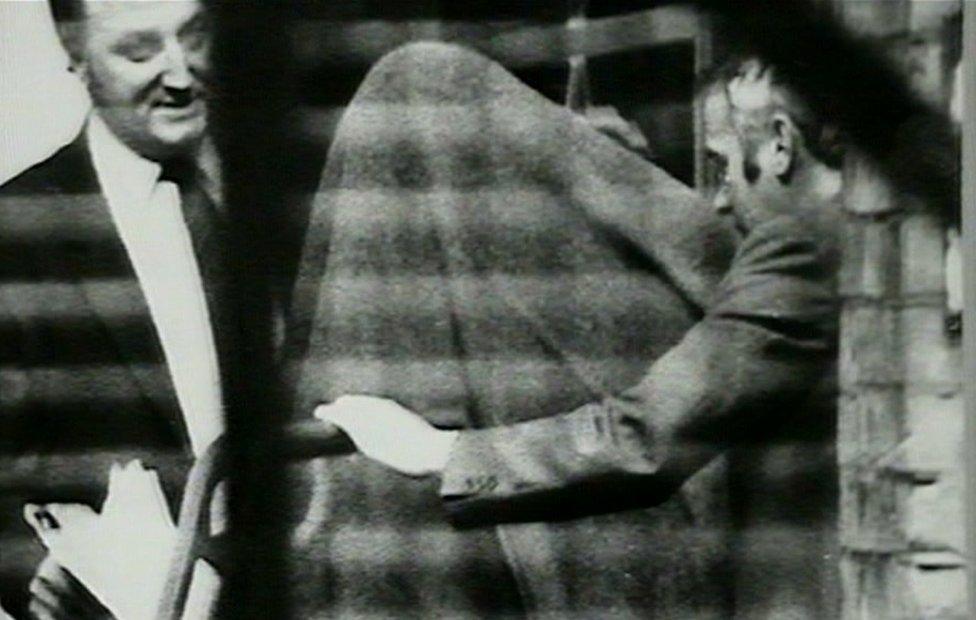Murderer jailed for 1986 rape thanks to DNA testing advances
- Published

John Bainbridge, pictured under a blanket following a court appearance in 1987, had previously been jailed for murder
A convicted murderer has been given a second life sentence for a rape he committed 30 years ago - thanks to advances in DNA testing.
John Bainbridge, now 54, raped a mother at knifepoint in front of her two children in Nottingham in May 1986.
He then murdered a woman in similar circumstances in October 1986, and was jailed for this.
Police always suspected the two crimes were linked but had not been able to prove it until recently.
Semen samples taken as evidence in 1986 were tested using DNA-17 profiling, a more sensitive test that has only been used by police since 2014.
Bainbridge had been released from prison and was living in Burton-on-Trent in Staffordshire when police arrested him in June 2016.

John Bainbridge has been given a second life sentence, and will serve a minimum of eight years before being considered for release
Bainbridge initially denied rape and had been due to stand trial, but he changed his plea on Friday at Nottingham Crown Court.
The judge told him he will serve a minimum of eight years before being considered for release.
Bainbridge planned both of his attacks and targeted the women after their husbands had left their homes.
He raped his first victim, who was then aged 34, in Vernon Road, in the Basford area of Nottingham, on 15 May 1986.
He was armed with a knife, which he used to threaten her and also cut open her underwear.
'Shut up or I'll kill him'
One of her children was already in the room, but Bainbridge made her call the other child in, meaning both children witnessed their mother being attacked.
He also threatened to kill one of the children, who was upset, shouting at the other to "shut up or I'll kill him."
Adrian Langdale, prosecuting, said: "She went on to describe to police how she tried not to struggle or fight for fear of her own safety and that of her children.
"It may well be that that particular action by her saved not only her life, but her children as well."

John Bainbridge murdered Rosemary Scott by stabbing her in the chest - five months after he raped another woman
Five months later Bainbridge murdered his second victim - 43-year-old Rosemary Scott - by stabbing her in the chest at Simkins Farm in Adbolton Lane, West Bridgford, on 16 October.
He cut open her underwear with the knife, mirroring the way he had attacked the other woman.
Police believe the attack was sexually motivated, and he stabbed Mrs Scott while she struggled to defend herself.
He was given a life sentence for this in 1987, and originally served 20 years before being released.

He attacked Rosemary Scott at Simkins Farm in West Bridgford, pictured here in 1986
However, he was sent back to prison twice for breaching his licence conditions, meaning he has already served 26 years and 10 months in prison.
Det Insp Justine Wilson praised the rape victim and her children, who were all prepared to give evidence if the trial had gone ahead.
"I absolutely give the best praise for the courage that both the victim and her two children have had to come forward," she said.
"One of her reasons behind it was she didn't want this man out on the street, she wanted him locked up so he could never, ever, do this again to anybody else."
Lawrence English, from the Crown Prosecution Service, said the case shows how valuable it is to preserve all evidence in a case.
"There is no doubt that this conviction was made possible by the decisions by the police all the way back in 1986 to keep and preserve the samples, despite not knowing how DNA technology would develop," he said.
"Advances in technology now mean that we can match DNA to a suspect, regardless of how long ago the samples were taken."
- Published4 July 2016

- Published19 June 2016
